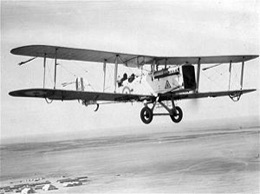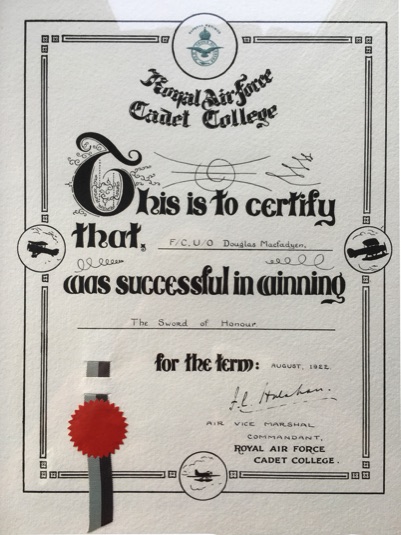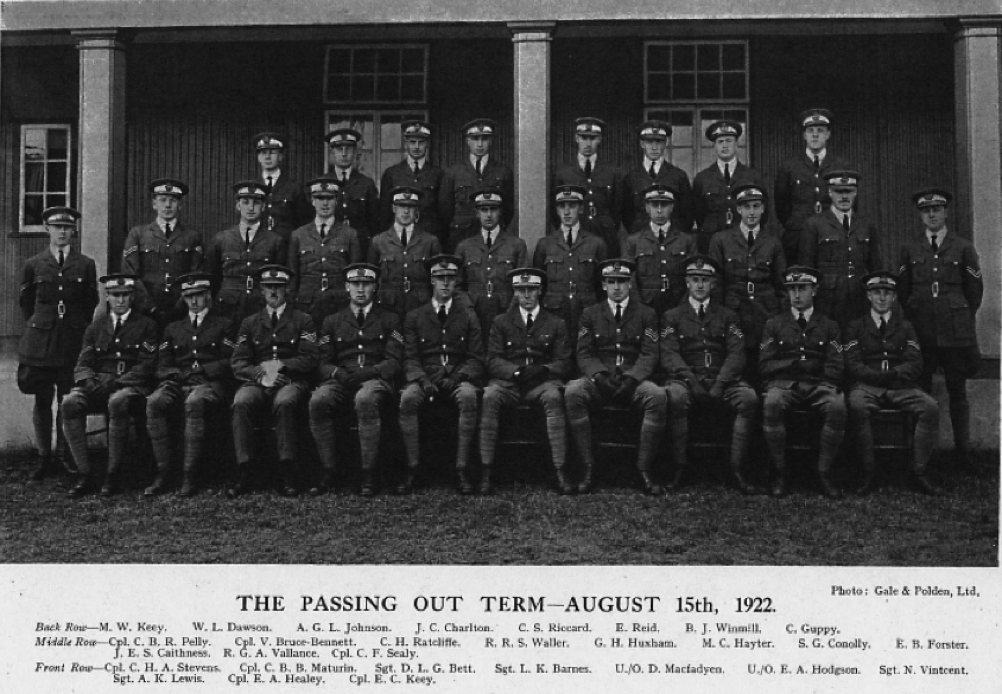Graduation Reviewing Officer
Commandant



20-9 Entry September 1920 - August 1922
Barnes Leonard B Blundell's
Bennett Victor B King's School, Rochester
Bett David B Berkhamsted
Caithness James A Dartmouth
Charlton John B Thames Nautical College
Coventry Edward B Haileybury
Dawson Walter B Halton
Glenn Robert Dublin University
Gray Sandy Mount St Marys College
Guppy Cecil A Stirling House, Bournemouth
Hancock Richard Cheltenham
Healy Ernest A St. Columba's College, Dublin
Hodgson Edgar A Wicklow Academy
Johnson Anson B Ampleforth
Keey Edward A Imperial Service College
Keey Montagoue B Imperial Service College
Larpent Elbert Bedford
Lewis King A Worcester Cathedral Kings
Lindsay Samuel Cork GS
Macfadyen Douglas B Newcastle Royal G.S.
Maturin Charles B Wellington
Pelly Claude B Rugby
Ratcliffe Charles B Dulwich College
Reid Ellis A Dartmouth
Riccard Cecil A Cranleigh
Rogerson William Kings College
Sealy Charles A Marlborough
Stevens Charles B Sherborne
Vallance Roper A Marlborough
Vintcent Neville A Dartmouth
Waller Robert B Harrow View School
Winmill Beverley Dartmouth
(*26 Graduates in bold)
The second 1920 intake of 32 cadets* divided into A and B Squadrons
Mortality
Of the 26 entrants who were commissioned 6 (23%) of these officers were subsequently killed in action or in flying accidents.
Edward Coventry 29/9/1923
Ricard Hancock 10/6/1941
Edward Keey 15/10/1923
Ellis Reid 12/11/1924
Robert Waller 10/5/1925
Neville Vincent (29/1/1942)
Plt Off Edward Bernard Coventry - Killed at Spittlegate, 29 September 1923 with Corporal William Wardle. He was carrying out a practice flight on a DH.9a E8695 (39 Sqn) and having taking off he stalled and fell into a spin. Both men killed instantly. Coventry had much experience on DH.9s, having been part of formation flying at previous Aerial Pageant. Graduate of Haileybury and Cranwell.
_________________________________
Wg Cdr Richard Hancock was killed in action on 10 Jun 1941. He was killed whilst flying in Proctor, P6256 of No 16 Sqn, which crashed on take off from Roborough after visiting the squadron detachment there. He is buried in Lustleigh Church Cemetery. Died as result of wounds 14/7/41
_________________________________
Plt Off Edward Charles Keey. He was serving at the Central Flying School and was attempting to land at Farnborough. He made a flat turn approaching after deciding to go around and stalled . He died in the ambulance taking him to the Cambridge Hospital.
15.10.23
_________________________________
Fg Off Ellis Reid (22) killed on 12 Nov 1924.
Prior to this he crashed a civilian Avro while 'in hospital'. Fainted in air and was severely injured.
He was killed whilst flying Snipe, F2499 of No 1 Sqn which spun into the ground at Hinaidi and is buried in Ma'asker Al Raschid RAF Cemetery.
_________________________________
Fg Off Robert Richard Studdert Waller (22) died 10.5.25
He was severely injured whilst piloting a Bristol fighter of No 31 Sqn on 9 May and died from his injuries the following day.
Night flying accident, Ambala, India
_________________________________
Neville Vincent 8 Squadron
In November and December 1923, most of the RAF Squadrons, including 8, went south again for operations against some marsh tribes in the area between the Tigris and Euphrates rivers. It was here that Pilot Officer Vintcent won the first Cranwell DFC. The way in which it was won is typical of the carefree spirit of those days. The Squadron was living in a train not more than ten minutes from the target area. Yet Vintcent, with Flight Lieutenant Jones as gunner, ran out of fuel and landed within a mile of the target! Taffy Jones was a famous WWI fighter ace with the DSO, MC, DFC, and MM. He also played rugby for Wales. The desert was quite flat so a second aircraft landed along side and the pilot suggested that Vintcent and Jones should climb in and return to base. This offer was declined and the second aircraft was sent for more fuel. When they were alone again some Arabs, not unnaturally, arrived from the target area and started shooting at them. At first, Jones managed to keep them at bay by replying with his Lewis gun from the back seat. Soon the Arabs realised that the gun could not fire forwards, so they started approaching from the nose. Vintcent, who was no weakling, picked up the aircraft tail by himself (normally it took two or three men to do this) and swung the aeroplane round so that Jones could continue to fire at the Arabs. This was successful for a while, but eventually they were forced into a position where Vintcent had to stand in front of the nose with a revolver to keep the attackers at a distance while both flanks and the tail were covered by the Lewis gun. The situation was beginning to look black when a Sopwith Snipe arrived and drove off the attackers. The petrol arrived shortly after this and no time was wasted in refueling and taking off.
Nevill Vintcent has an entry in the Commonwealth War Graves Commission which covers his death in January 1942 whilst flying as a passenger in an RAF Hudson which left Portreath in Cornwall but never reached its destination in Gibraltar. This information has been kindly provided by Nevill Vintcent’s son John Vintcent.


F/C Under Officer Douglas Macfadyen
Winner of the Sword of Honour.
His son Ian (83 D) was to awarded the same honour some 41 years later.
ACM Sir Hugh Trenchard Bart KCB DSO ADC

1/9/1920 - 15/8/1922